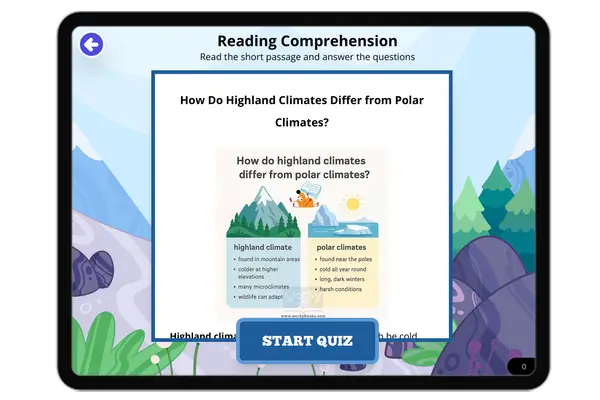What Is Condensation in the Water Cycle? — Passage
densation is a key part of the water cycle, which is the continuous movement of water through Earth’s systems. It happens when water vapor in the air cools down and changes back into liquid water. This process forms clouds, fog, and even dew on grass in the early morning.
Condensation begins after evaporation, when heat from the Sun turns liquid water into vapor. That vapor rises into the atmosphere. As the water vapor goes higher, the air becomes cooler. When the vapor cools enough, it turns into tiny water droplets. These droplets group together around small particles like dust and form clouds. Without condensation, we wouldn’t have any precipitation—rain, snow, sleet, or hail.
Temperature plays a major role in condensation. Warm air can hold more water vapor, but as the air cools, it can't hold as much. This is why condensation often occurs at night or early in the morning when temperatures are lower. It's also why you might see water droplets on the outside of a cold glass—the water in the air around the glass condenses when it touches the cold surface.
Condensation is important because it helps return water to the Earth's surface. It makes weather events like rain possible and is a part of the natural system that keeps water moving. Meteorologists study condensation to help predict weather, and engineers use it in machines like air conditioners and refrigerators.
Fun Fact: Every cloud you see in the sky is made up of billions of tiny water droplets formed by condensation!
What is condensation?
Water turning into iceWater vapor becoming liquidWater soaking into soilWater running off landWhat causes water vapor to condense?
Strong windsHeat from the SunCooling of airMovement of riversWhat forms when tiny droplets group together in the sky?
DewCloudsHailWindWhich process happens before condensation in the water cycle?
FreezingRunoffEvaporationPrecipitationWhy do water droplets form on a cold glass?
Ice is meltingGlass is leakingWater in air condensesGlass is evaporatingWhat role does temperature play in condensation?
Warmer air causes itCooler air causes itIt freezes waterIt speeds up sunlightWhat is the main idea of the passage?
Water vapor is dangerousClouds are made of gasCondensation turns vapor into liquidAir can't hold waterHow do air conditioners use condensation?
They heat airThey create cloudsThey cool vapor into liquidThey dry water








